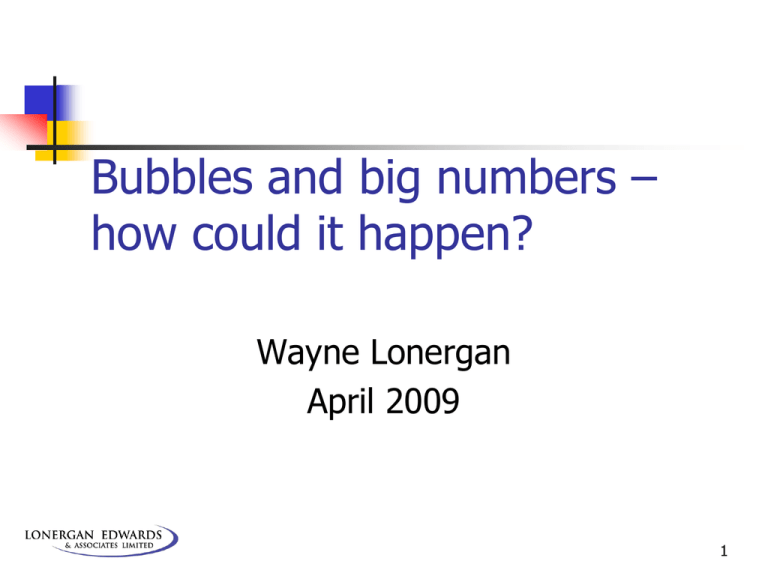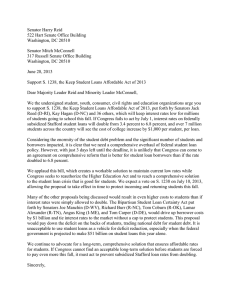Bubbles and big numbers – how could it happen? Wayne Lonergan April 2009
advertisement

Bubbles and big numbers – how could it happen? Wayne Lonergan April 2009 1 The main causes Falling interest rates Excess liquidity Under-priced risk Excessive F. Institutions leverage / growth Declining prudential standards Residential property boom Implicit assumptions 2 Second order causal factors Government policy Inadequate regulators Off B/S finance Securitisation Excessive remuneration / moral hazard Short termism Accounting issues* Unexpected double whammy* Valuation issues* Academics * * (Mostly) not yet outed. 3 Causality chain 4 The scale of the problem $bn $tn US$14.3tn US$5tn – – – – US$1.5 - $3.0tn – US$1.4tn – US$5,000 – 9 zeros 12 zeros USA GDP 2008 fall in market cap of banks (2007-09) estimate of US F.I. losses total stimulus etc. package (10% USA GDP) per person in USA Source: Economist 5 $10,000 – in $100 notes 6 $1 million – in $100 notes 7 $100 million – in $100 notes (fits on a standard pallet) 8 $1 billion – in $100 notes (10 pallets) 9 $1 trillion – in $100 notes (10,000 pallets – those below are double stacked) 10 Just another boom? Lower interest rates Increases ability to borrow Increases asset values Encourages more leverage Increases asset values Declining prudential standards Increases asset values + 11 Interest rates fell USA weighted average mortgage rate 1994 – 1997 9.0% 2000 6.8% 2008 5.2% USA sub-prime housing loan rate 2004 11.5% 2008 9.1% Credit spreads were low Volatility fell significantly Source: National Economic Accounts 12 Corporate spreads fell – Global Corporates AAA – Global Corporates AA – Global Corporates A – Global Corporates BBB Source: Bloomberg 13 Inadequate (for a time) credit spreads 14 Volatility declined – implied volatility of the S&P 500 and DAX Source: CBOE and Deutsche Borse Note: VIX and VDAX are indices of implied volatility for stock option prices on the S&P 500 and DAX respectively 15 Excess liquidity was created – USA domestic issues % of GDP p.a. Fall in savings ratio (2000 – 2008) 4.0 Balance of payments deficit (ave) (2000 – 2008) 4.8 Government deficit (ave) (2002 – 2007) 3.5 2000 +1.6% 2007 – 2.8% NB! Cumulative impact over 8 years Source: USA National Economic Accounts 16 Excess liquidity – international issues Undervalued currencies created surpluses recycled to USA (eg China) Imprudent lending (e.g. large loans to eastern European countries) Widespread foreign currency denominated borrowing (eg Czech) Reckless lending / expansion (e.g. Iceland) 17 Risk was underpriced Corporate bonds spread over govt bonds (B.PTS) AA BBB Difference 6/05 56 84 28 6/06 53 75 22 6/07 58 88 30 6/08 216 267 51 2/09 248 50 255 Source: RBA 18 Risk was underpriced cont. Five year credit default swaps AA BBB Difference 6/05 12 49 35 6/06 9 44 35 6/07 5 50 45 6/08 84 142 58 2/09 189 398 209 Source: RBA 19 National debt levels exploded Source: FSA 20 National debt levels exploded cont. Source: FSA 21 Household indebtedness rose USA Australia UK % of disposable income 141 156 177 Source: Prof N. Ferguson (Harvard) 22 Role of financial institutions* Excessive leverage Inadequate (no?) review of credit quality Off B/S structures Excessive proprietary trading Short-term focused remuneration incentives Culture of greed Reliance on flawed formula With a few notable exceptions e.g. Allco, B&B * Not in Oz 23 Average bank and investment bank leverage became excessive Reported debt to equity leverage USA 25 (+) Eurozone 30 – 60 (+) UK bank debt 440% of GDP Source: Centre for European Policy Studies, Prof N. Ferguson 24 European banks ranked by total assets (€ million) Bank Total assets June 08 Total assets end 07 Mkt Cap Oct 2008 (Billion) Lev ratio June 08 Lev ratio end 07 HSBC 2,546,678 2,354,266 140.9 20.1 18.4 RBS 2,463,214 2,579,194 37.2 18.8 20.8 Deutsche Bank 1,990,740 2,020,349 24.4 59.1 52.5 * BNP Paribas 1,817,193 1,694,454 59.1 36.1 31.5 Barclays Bank 1,726,187 1,654,652 37.0 61.3 52.7 * Credit Agricole 1,464,822 1,414,223 32.3 40.5 34.8 ING Group 1,369,947 1,312,510 33.8 48.8 35.3 UBS 1,292,081 1,370,820 42.1 46.9 63.9 * Societe Generale 1,075,925 1,071,762 37.5 30.3 39.3 UniCredit 1,059,767 1,021,504 37.7 19.0 17.7 Source: CEPS 25 European banks ranked by total assets (€ million) cont. Bank Total assets June 08 Total assets end 07 Mkt Cap Oct 2008 (Billion) Lev ratio June 08 Lev ratio end 07 Fortis 974,343 871,179 12.9 33.3 26.4 Credit Suisse 764,828 820,762 34.6 33.4 31.5 Commerzbank 615,223 616,474 8.5 39.9 38.2 Dexia 613,708 604,564 9.8 64.4 41.6 Intesa Sanpaolo 572,902 572,902 48.2 11.1 11.1 BBZ Argentaria 504,990 502,204 43.4 20.1 18.6 Lloyds TSB 464,876 479,185 19.8 34.1 31.0 Hypo Real Estate Holding 395,422 400,174 1.1 83.0 65.9 KBC 377,351 355,597 21.9 24.4 20.5 Standard Chartered 251,287 224,092 25.1 19.5 15.8 Deutsche Postbank 202,991 202,991 4.8 38.2 38.2 Banco Popular 108,928 107,169 10.3 16.6 17.2 Source: CEPS 26 Plus risks not recognised – taking risk off B/S Traditional Deposits funds loans Loan originator = ultimate funder Securitised Securitised Deposits funds loans Loan originator and packager ≠ ultimate funder * Shaded = no capital unregulated 27 AAA rated entities / securities Companies rated as AAA CDO’s etc rated as AAA in 2007-8 12 62,000* *One AAA ratings issue every 15 minutes per working day Source: Goldman Sachs 28 Lending complexity increased, participants and roles changed Traditional model Loan originator (bank) makes loans, funds, holds to maturity Securitisation model Loan originator (broker) makes loans, investors fund / trade / hold to maturity 29 Lending complexity increased, participants and roles changed cont. Advanced securitisation model Loan originator / broker makes loan Intermediaries slice, trade, hive off risk and improve / enhance apparent credit status with CDS and credit insurance 30 Advanced securitisation Slice, hive, improve, trade* AAA AA A BBB BB B Equity AAA Credit insce / CDS AA A BBB *No acronyms please BB CDS2 CDS 3 (etc) Equity 31 The USA residential debt binge 2000-2008 US residential debt Disposable income Ratio residential debt to DI 30 year loan average minimum repayment +122% +47% +51% +90% Source: Freddie Mac 32 Declining prudential standards Excessive leverage (US FI 30:1, Fannie Mae 70:1, Credit Insurers 100:1) Low doc. Loans (sub-prime 35%, ALT – A 71%) Low / no deposit loans Blind faith in credit ratings Misplaced faith in credit insurance / CDS Credit ratings agencies Conflicts: Defence counsel and judge Paid by issuers 33 What’s different about USA property loans Non-recourse Mostly fixed rate (90% +)(1) Rate based on LTBR No / low penalty for early payout(2) Tax deductible interest for borrowers Loan initiators distanced from ultimate financiers Note: 1 Hard to ameliorate debt burden 2 Interest rate risk, either way, for lenders. Also encourages “trading up”. 34 USA Residential property boom Interest rates fell Incomes rose LVR increased Values increased 35 Financial impact on USA residential borrowers US$bn % of increase Annual housing loan service cost – 2000 497 Income increase 174 38 Interest rates fell 113 26 LVR increased (78% - 88%) 128 28 37 8 Other (low doc, step up rates, etc) Annual housing loan service cost – 2008 Cyclical 36% 949 36 Declining loan quality Qualitative decline – more loans to lower income earners (HSG AWE 64%, UG AWE) Traditional counter cyclical deposit constraint removed (+ LVR) Traditional interest constraint payment removed Deferred interest step ups (2004) initial rate 7.3%, full rate 11.5% Low doc / no deposit loans Loans initiators distanced from borrowers LVR 78% to 88% (ave) Some LVR 105% - 110% 37 Total US home mortgage loans lending boomed 2000 US$tn 5,500 2008 12,200 122% Source: National Economic Accounts 38 Increasing leverage ratio on housing 39 Loan originations by type 40 Some Freddie Mac statistics (3/09) % of loans Freddie Mac portfolio (ave) Ltv – 2005 56% – 2008 72% Freddie Mac portfolio ($2.2tn) – LTV 90% - 100% 10% – LTV 100% (+) 13% – sub-prime % of portfolio 34% USA residential debt – 2009 $12.4tn – 2015 forecast $19.7tn USA residential debt / house value Fall in residential house values 3Q 2006 to 4Q 2008 57% 16.8% Freddie Mac / Fannie Mae – Total debt – Total US government debt $5tn $9.5tn 41 Home ownership rate 42 Case-shiller home price index 43 Source of funds for Freddie Mac’s MBS’s 44 Implicit assumptions were ill founded (as always) A new paradigm AAA means AAA Houses are a safe investment Credit insurers could cover losses Financial instruments reduce systemic risk Lenders will roll over on maturity No double whammy (assets fall, liabilities rise) Different states = diversification Recent low bad debt experience would continue 45 Government regulators exacerbated / caused / ignored problems USA UK Aust Caused / exacerbated problems Home lending encouraged Y Y Y Inadequate bank F.I. regulation Y Y N Large federal deficit Y Y N 46 Government regulators exacerbated / caused / ignored problems cont. USA UK Aust Inadequate / no response to debt explosion Y Y N Excessive property prices Y Y Some Excessive dependence on financial services sector Some Y Some Basel I K adequacy encouraged house mortgage lending Y Y Y Basel II introduced N Y Y Ignored problems 47 Excessive remuneration / short termism Excessive focus on STI Bonuses US$bn Hedge fund management fees 33.0 Wall St bonuses 3 years total* 35.0(+) Bear Stern 11.3 Lehman Brothers 21.6 Merrill Lynch 45.0 Ave p.a. 26.0 * Seems very low c.f. BS/LB/ML Source: Economist 48 Failure to identify there were two types of risk Quantifiable expected deviation Unquantifiable unexpected (Fat Tail) deviation 49 Australian property valuation issues Property valuers look backward No conceptual framework in property DCF rare Excessive leverage “Hedged” borrowings Cheap trust capital used for development risks 50 Australian infrastructure valuation issues Imputation credits reduce Ke Capital / loan distributions viewed as “income” Excessive leverage Declining interest rates created illusion of value creation “Tame” valuers Inter entity “sales” 51 Valuation issues – other corporates Values depended largely on IA Widespread “in house” ownership meant no back up capital Non-recurring (in house) fees capitalised as if recurring Pyramid structures Mainly “I” entities Allco, B&B, etc Reliance on offshore debt capital 52 Valuation issues – Australian banks Relied on property valuations Recognise losses only when incurred (AIFRS) Reliance on offshore debt capital 53 Accounting standard contribution (not yet “outed”) Off B/S finance allowed Market price confused with market value Pro-cyclical reporting (K transactions / MTM in headline profits) Hedge accounting (asset value fall plus hedge liabilities rise) Bad debts not recognised until “incurred” Recycled profits on first time adoption (developers) 54 Accounting standard contribution (not yet “outed”) cont. Permitting VIU Not explaining VIU Allowing CGU’s to change Not amortising goodwill (preservation of capital, discouraged takeovers) Allowing mining co to show ore reserves as goodwill Short 5 year PV horizon for impairment 55 Unexpected double whammy Asset values fell Liability values rose Impact of low Rf rate on liability values not yet widely recognised (govt, insurers, PB super, etc) 56 Not just a USA/UK problem 57 Failure of academics To emphasise business fundamentals (LTA with LTD, liquidity, leverage limits) To demonise VIU Belief in VAR Belief in “rational” markets Belief in EMH Modigliani / Miller (D/E curve become exponential) Li formula (priced CDO by correlation metric) Belief Gamma factor reduces c of k and + value 58 Summary and conclusion “The United States owes debts everywhere … it is nothing but a paper Tiger” Mao Tse-Tung (Zedong) 1956 59 Recommended reading Available from leading book stores or Allen & Unwin www.allenandunwin.com Available from leading book stores or Sydney University Press www.sup.usyd.edu.au (Alternatively contact Lonergan Edwards on 02 8235 7500) 60



